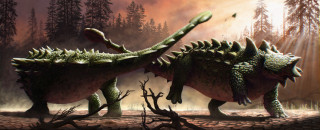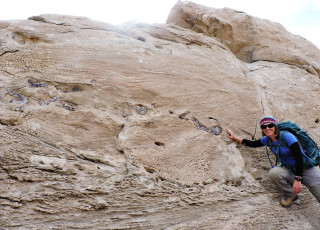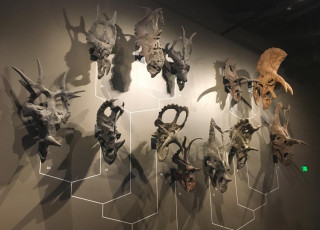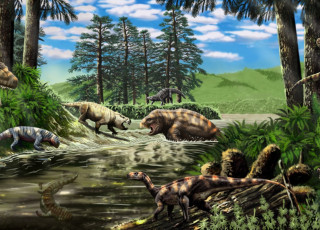How One Amazing Fossil Is Upending Our Understanding of Ankylosaur Behavior
Note: Dr. David Evans will be a keynote speaker at NHMU's DinoFest: Damage & Defense on January 27-28, 2024. Learn more and prebook DinoFest tickets here.
By Daniel Potter
For paleontologists trying to tease hints from fossils mangled by geologic time, insights into the activities of a particular dinosaur are precious.
Consider the ankylosaur, a four-legged Cretaceous plant-eater known for its armor plates and hefty club-like tail. You’d be forgiven for imagining this tail club was well-suited for kneecapping any would-be predator like T. Rex. Not out of the question, says one expert, Dr. David Evans of the Royal Ontario Museum, but he suspects ankylosaurs evolved such tail clubs for a wholly different purpose—one that reveals something about how these dinosaurs spent their days.
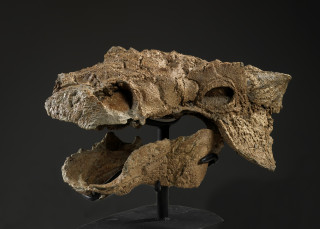
Zuul crurivastator skull. Image courtesy of David Evans
Evans’ argument concerns a remarkable specimen from Montana that he and Dr. Victoria Arbour first described in 2017 as a new species of ankylosaur, Zuul crurivastator. We’ll unpack that name and its backstory further down, but for now, know that “Zuul” is also something of a mononym, as in: “We are not sure exactly how old Zuul was when the specimen died 76 million years ago, but we are certain that it was quite an old individual that lived a full life.”
“It’s pretty much complete from the tip of the nose to the tip of the tail,” Evans says. While the specimen’s legs are missing—nothing is perfect—what’s there is more than just bones. “And this is where Zuul is really, really special. Probably most of the body is the fossilized skin… So all of the armor plates are in place on the back, and it’s all covered in fossilized skin.”
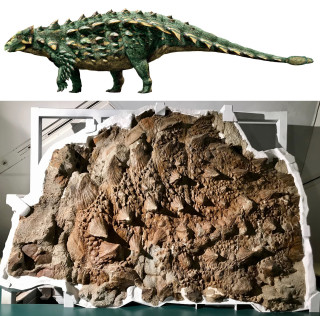
An illustration of Zuul (top) and a photo of the fossilized armor (bottom). Image courtesy of David Evans
That bony armor wasn’t just for show. Along Zuul’s flanks, its spikes, or osteoderms, show signs of repeated injury and healing. Close analysis suggests those injuries weren’t from thwarted attacks by hungry predators, but are what you’d expect from “intraspecific combat,” as Evans and Arbour put it in a 2022 paper with Dr. Lindsay Zanno. That is, they think these ankylosaurs were wailing on each other with their tail clubs:
“There is little doubt that the tail club could have been used in defence when needed, but our results suggest that sexual selection drove the evolution of this impressive weapon. This changes the prevailing view of ankylosaurs, suggesting they were behaviorally complex animals that likely engaged in ritualized combat for social dominance as in other ornithischian dinosaurs and mammals.”
In this type of combat, Evans says, “animals tend not to fight each other to the death. It tends to be a test of strength… The animals can exert their dominance, but without killing the other animal.” This explains why Zuul’s injuries are concentrated around the hips, where a mortal wound would be unlikely, rather than the ribs or head.
The discovery that Zuul’s injuries likely owe to “jousting” with others of its club-tailed kind points, in turn, toward a heretofore underappreciated social complexity, upending a century-old notion of ankylosaurs as dimwitted loners. This insight into not just what Zuul crurivastator was but how it lived will feature in a keynote Evans is set to give later this month as part of the Natural History Museum of Utah’s two-day DinoFest event.
Origin Stories
“I am your typical dinosaur kid,” says Evans, a paleontologist at the Royal Ontario Museum in Toronto. “I have wanted to be a paleontologist since I can remember—and since my family can remember.”
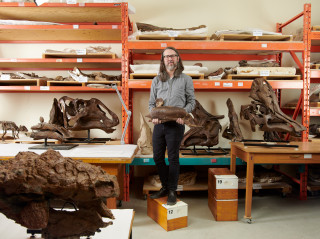
Image courtesy of David Evans
His first exposure to dinosaurs was a book his grandmother gave him with he was 3 years old. At age 4, his family took him to the very museum that now employs him, “and from that point on, I always wanted to be a paleontologist, and that’s what I worked my whole life to be. One of my dream jobs was to be the paleontologist at the place where I first saw real dinosaurs, and I’m literally living my childhood dream.”
This telling of the story skips over a few beats, but if you’re wondering, they include a bachelor's degree (2003) from the University of British Columbia and a Ph.D. (2007) from the University of Toronto’s Department of Ecology & Evolutionary Biology, where he is now an associate professor. He has been party to the discovery of more than a dozen new dinosaur species.
As for his DinoFest talk at NHMU, it’s titled “Zuul: Armored Dinosaur Fight Club.” The pun calls to mind a line from the 1999 cult movie Fight Club, in which, like ankylosaurs, some dudes wail on each other. But while Brad Pitt declares, “I don’t want to die without any scars,” this was decidedly a non-issue for Zuul. That name also happens to be a movie reference.
Who You Gonna Call?
The original paper introducing Zuul crurivastator says the name “refers to Zuul the Gatekeeper of Gozer, a fictional monster from the 1984 film Ghostbusters,” while “crurivastator” is Latin for “destroyer of shins.”
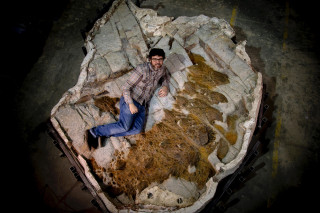
Dr. David Evans lays next to the fossilized armor of the ankylosaur "Zuul." Image courtesy of David Evans
The Zuul of Ghostbusters is a “terror dog” to which, Evans observes, our Zuul bears a striking resemblance: “It has this short, rounded snout with wrinkly scales that run over the top of the nose onto the forehead. It’s got the horns that sweep back behind the eyes, and the spikes on the neck even.”
When Arbour first thought of the name “Zuul,” Evans knew just who to call. He happened to have a connection to Dan Akroyd, who co-wrote and stars in the movie, “because I actually taught his family how to dig up dinosaurs for a fundraising event for another museum a few years earlier.”
Evans reached out about using the name, and Akroyd “was so excited. He responded immediately and was like, ‘Absolutely, it’s such an honor. These armored dinosaurs were my favorite dinosaurs when I was a kid.’” The Emmy-winning SNL alum even appeared in a short behind-the-scenes video comparing the cinematic terror dog to the “real” terror dog.
Zuul’s Next Act
After a stint in Japan, where it was the centerpiece of Dinosaur Expo 2023, Zuul is now back in Toronto, where it still has plenty more it can tell us, Evans says.
“One of the exciting things about the soft tissue preservation is that we have a lot more work to do there,” potentially at a molecular level that could reveal much more about Zuul’s life, possibly down to details about what it was eating and the world it lived in. Purely from the standpoint of writerly convenience, it would be handy to find out whether Zuul was a he or a she; one day soon, we might.
Though Evans cautions we’re not there yet, “we’ve done some preliminary analysis that shows that we do seem to have some soft tissues preserved at the molecular level, which is really exciting. Who knows where that can lead?”
Dr. Evans at DinoFest 2024
Learn more about Dr. Evans’ research on Zuul crurivastator during his upcoming lecture at NHMU’s DinoFest, happening January 27–28 at the Museum in Salt Lake City.
